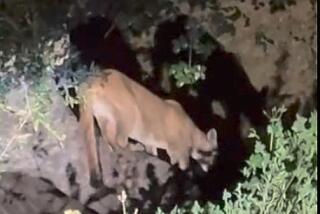NEARLY EXTINCT SPECIES : Monterey Park’s Ultralight Police Surveillance Plane, Grounded by Lack of Insurance, to Go to Smithsonian
- Share via
Like the prehistoric flying reptile an ultralight resembles, the Monterey Park Police Department’s pioneering use of the unusual aircraft faces extinction.
And like the prehistoric pterodactyl, the plane will be enshrined in a museum.
Monterey Park, whose use of the tiny craft to track criminals brought the San Gabriel Valley city worldwide attention, is donating its latest ultralight to the Smithsonian Institution in Washington.
Three years ago, the Police Department donated its first ultralight to America’s premier collection of aeronautical treasures. But at that time, another ultralight continued to patrol the skies above Monterey Park.
This time, the city’s donation of to the Smithsonian’s National Air and Space Museum follows two years of unsuccessful efforts to obtain affordable liability insurance for the ultralight--and there are no plans for new flights.
Russell E. Lee, a curatorial assistant at the Smithsonian, said the museum wants the newer ultralight because it is more advanced than the first plane.
The city’s first ultralight, launched in September, 1982, was not much more than a hang glider with a motor and a makeshift, bulletproof seat.
Piloted by officers whom Police Capt. Joseph Santoro termed as bold as barnstormers, the plane assisted ground patrols in hunting for suspects and conducting surveillance.
The single engine was started like a lawn mower. The open-air seat was not much bigger than a bicycle’s. But after six months of engine failures and the arrest of two burglars and a robber, the first plane was retired.
After aviation experts verified that Monterey Park’s plane was the first ultralight in the world to be used by law enforcement, the aircraft was accepted by the Smithsonian.
That plane has not yet been put on display. It is being housed in a warehouse in Maryland, the same place the city’s latest ultralight will be stored, until an ultralight exhibit can be staged, Lee said.
Monterey Park’s current ultralight--the third such plane the department has used--includes an optional bulletproof enclosure fashioned by the plane’s Canadian manufacturer, which donated the plane to the city.
The two engines, to provide a backup in case one failed, were started electronically. Airspeed was three times the first plane’s cruising speed of 32 m.p.h. to 35 m.p.h., and the plane had the ability to quickly take off or land.
The Smithsonian now has four ultralights, which sprang from the hang glider movement of the 1970s, according to Lee. Among the 336 aircraft in the collection, which includes Lindbergh’s “Spirit of St. Louis” and the craft flown by the Wright brothers and Amelia Earhart, the Monterey Park ultralight is the only one used in law enforcement.
Santoro got the idea for using an ultralight in 1981 after watching a boy fly on the television show “That’s Incredible.” The plane seemed to have the potential to serve some of the same purposes as a helicopter for small police departments, which might not be able to afford the more expensive craft.
Eventually, Santoro persuaded his superiors and a New Mexico ultralight company, which contributed the first two planes used by the city.
Soon “That’s Incredible” featured Monterey Park’s plane. Inquires came from Tasmania, Japan and Jordan.
The plane amazed onlookers when it flew over a 1984 Summer Olympics Games site in Monterey Park. The Alabama Department of Corrections sought advice from the city and so did a delegation from Australia.
Other police departments, including those in Downey and Tempe, Ariz., acquired ultralights. Tempe has ceased using them, however, citing the inability of the plane to withstand the constant use demanded by police work. Downey, which is part of a group of two dozen cities that join together to get insurance, still uses its ultralight up to six hours a day.
Monterey Park continues to receive calls from other interested police departments. Earlier this year, Azusa considered buying Downey’s ultralight, but was unable to obtain insurance.
“Insurance is a common problem,” said John R. Ballantyne, president of the Maryland-based U.S. Ultralight Assn. The organization does not know how many law enforcement agencies still have ultralights, but Ballantyne said he does not believe that their use has become widespread. “Ultralights are an additional surveillance tool, not the total answer,” he said.
Despite their latest gift to the Smithsonian, approved by the Monterey Park City Council last month, Monterey Park police have not totally given up on the idea of taking off again. Still around, being kept in mothballs, is the city’s second ultralight, which was pulled from service after it was slightly damaged in an accident several years ago.
If the city can obtain insurance, Santoro said, “who knows what we can do with it.”
More to Read
Sign up for Essential California
The most important California stories and recommendations in your inbox every morning.
You may occasionally receive promotional content from the Los Angeles Times.










